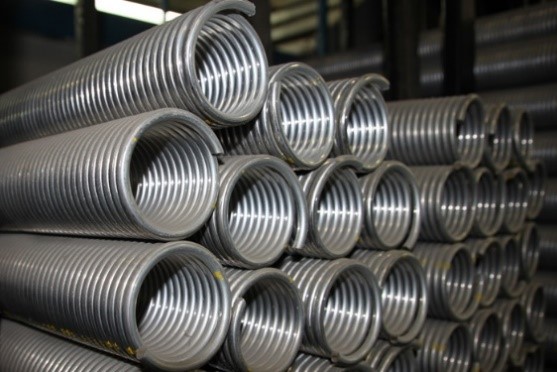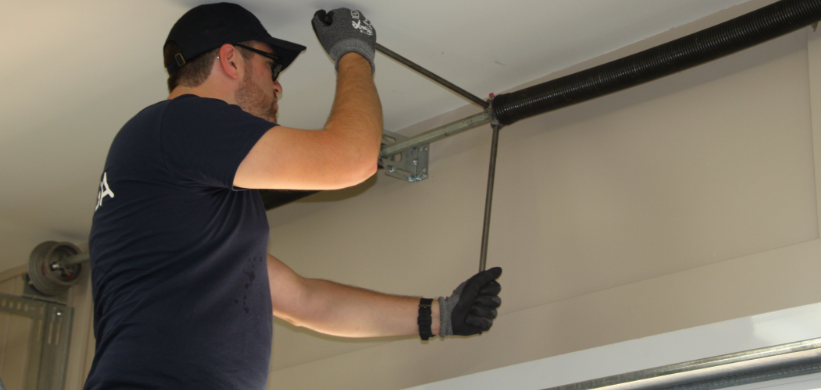The springs on your garage door probably aren’t on your mind every day. Unless you’re considering a new garage door or opener or yours happens to break down, it is not something that people usually even think about. This system is placed on the interior of the door to help counterbalance its weight, offering easy manual or electric operation by making the door seem much lighter.
The torsion spring system in your garage door is a major component that is going to require some special attention.

Getting started: The basics
Overhead doors have two types of available spring systems: extension and torsion springs. Extension springs are designed to go over the track while torsion springs are located over the door itself.
Torsion springs are far more common in both residential and commercial applications for three basic reasons: noise level, safety, and function.
This system is quieter than its counterpart because it is actually affixed to the wall rather than the door frame or track system, which offers quieter operation. These springs are also inserted into shafts, which means that if they break, it stays attached. With an extension spring, a snapped spring without a backup safety cable will usually go flying and can cause a lot of damage.
The torsion system also offers better door operation because it is installed on the anchor of the shaft above the door, which results in less vibration than the extension system installed over the tracks.
What is “torsion” anyway?
Torsion systems have many uses beyond garage doors. These springs are coil‑shaped, designed to work by twisting (torsion) and storing energy to make opening and closing the door easier both in the case of manual and electric operation. This is much more efficient than traditional counterweight systems of decades past.
Springs are only one piece of the puzzle
Anyone who has ever seen torsion systems in action knows that they are only one part of the larger garage door system. The spring itself cannot work without all of the necessary other parts, including the shaft that holds the spring.
Spring + Shaft + Drum + Lifting Cable + Bottom Bracket = Torsion spring system
Here’s how it works:
The spring is inserted into a shaft, which is held by a plate that attaches to the garage wall. This shaft is then connected to a drum that is grooved to hold the lifting cable. The cable is also attached to the bottom of the door with a bracket, creating a full transference of weight and energy when the door is closed. When the door is opened, the spring system will be in a relaxed state.
How much does a garage door actually weigh? While you should feel like your garage door only weighs:
- A 1 ¾” steel door that is insulated weighs about two pounds per square foot of door, with an added two to three pounds for each window on the door.
- A 2” steel door that is not insulated weighs around 1.5 pounds per square foot
A single 9x7 foot garage door will weigh between 150 and 160 pounds in the former example and closer to 130 pounds with the thicker non‑insulated door. A double door measuring 16x7 feet will weigh 280‑295 pounds, on average, based on this example.
Spring System FAQs
Here are some more common questions about torsion spring systems and how they work:
-
Do springs have to be installed on a certain side?
Garage door springs can be installed on the right or left of the door. Torsion systems do not require a specific position in order for the door to function properly.
-
How many springs should my door have?
Single doors that measure 9x7 feet (approximately) will require a single torsion spring. Double doors will use two springs.
-
How long do springs last?
Garage door springs are usually rated by manufacturers to last for as many as 10,000 cycles. A cycle is one full opening and closing of the door, not just a one-way trip. The average homeowner uses their door 2‑3 times per day, which means the springs should last for seven years. If the door is used more frequently, consider upgrading to springs that are rated for up to 25,000 cycles.
-
Will my springs rust?
Garage door springs are made with zinc, which comprises about 35‑40 percent of the metal in the spring. This can help protect against rust, but there are also better rust‑resistant springs out there for extremely damp garages.
-
How can I make my springs last longer?
You can protect your door from premature wear and damage by properly lubricating all of the working metal parts, including your torsion spring system. Regular lubrication can also eliminate excessive noise. Use petroleum‑based products for garage door springs.
-
How can I tell if the springs are working correctly?
If your door has an electric opener, you need to disengage it by pulling the red emergency release cord. Then, you should try to lift the door manually. It should feel light to lift and only require one hand. If it requires excessive effort or isn’t operating properly with manual use, the springs may be to blame.
-
Are springs always at the front of the door?
Springs are typically installed on the front. However, if there is less headroom over the door (under 12 inches), springs are mounted in the back and a double horizontal track system is utilized.
Never attempt broken spring repairs
It can never be said enough: changing broken garage door springs is extremely dangerous.
If you live near Pocasset or in the surrounding area, let our trained technicians help you with your garage door spring issues. Contact us at 508‑563‑5633 to discuss how we can help repair these high‑tension parts or request your own email quote to get things back in working order.










Add new comment